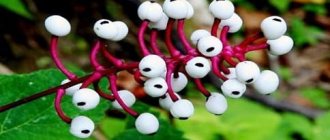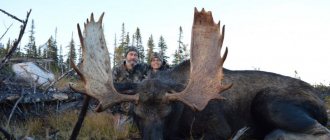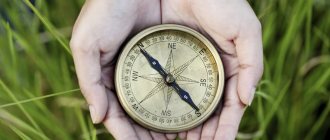» Mushrooms » Edible mushrooms » Morels - what spring mushrooms look like
0
801
Article rating
Morels are very popular among mushroom pickers. Their caps have an unusual wrinkled shape, consisting of numerous folds - hence the name. Let's look at where mushrooms grow and how they are used in medicine and cooking.
Morels - what spring mushrooms look like
Types of morel mushrooms
The Morel genus has not yet been well studied. There are more than 80 species in this group. This is a complex classification that is constantly changing and does not have clear criteria. All varieties have a similar structure and are considered conditionally edible.
Tall morel
The variety is distinguished by its large size: it reaches 5 - 15 cm in width, 30 cm in height. The fruiting body is dark in color, covered with triangular-shaped cells and narrow vertical folds. Specimens are collected in May, less often in June. The tall species is found on the edges of forests and mountainous areas.
In young specimens, the cells are brown with an olive tint, in mature specimens they are brown, almost black, and the partitions are ocher. The mushroom stem is cylindrical and has a granular texture. Its height reaches 15 cm, diameter - 3 cm. The leg, initially white, gradually becomes yellowish.

Conical morel
In the conical variety, the cap has an elongated shape, its edges grow tightly to the stem. The height is from 6 to 18 cm. The diameter of the cap is from 2 to 8 cm, the height is up to 9 cm. The color of the conical representative is varied, from yellow to brown. Most often they are brown or grayish in color.
The inside of the cap has an empty cavity. On top there are convex folds of a darker color. Externally, the surface resembles cells stretched from top to bottom.
The leg is cylindrical, up to 5 cm high, 3 cm thick. Its inner part is also hollow. The surface of the leg is velvety, covered with grooves. The flesh of the conical type is cream or white. It is thin, fragile, tender, and dries quickly. There is no taste or smell.
Important! Conical morels are quite rare. The fungus grows slowly, this process takes up to two weeks.
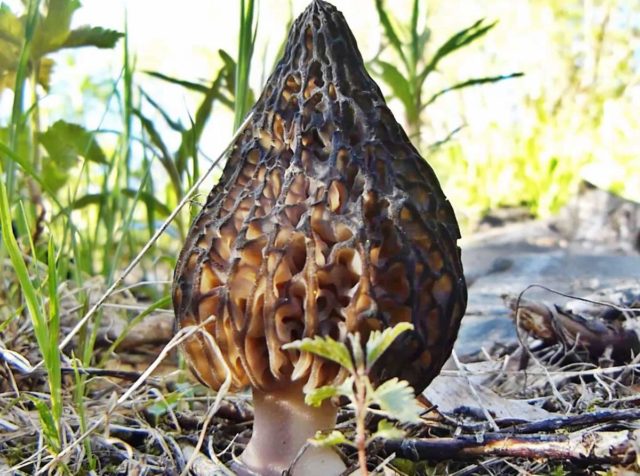
Real morel
Edible morel, or real morel, is the most popular variety. Its fruit body is large, fleshy, the inside is hollow. This mushroom reaches a height of 20 cm, while having a small mass.
Representatives of this species have an egg-shaped cap, often round, sometimes flattened. The edges are in close contact with the leg. The height of the cap is up to 7 cm, its girth reaches 3 - 8 cm. There are specimens with yellow, brown and gray colors. Gradually their color darkens. The cap has an uneven surface; it consists of numerous depressions.
The edible leg is hollow, cylindrical-shaped, with voids inside. It breaks easily and has a whitish color. With age, this specimen acquires a yellow or beige color. Its pulp is light, ocher or cream in color, and is easily crushed. The taste is pleasant, there is practically no smell.
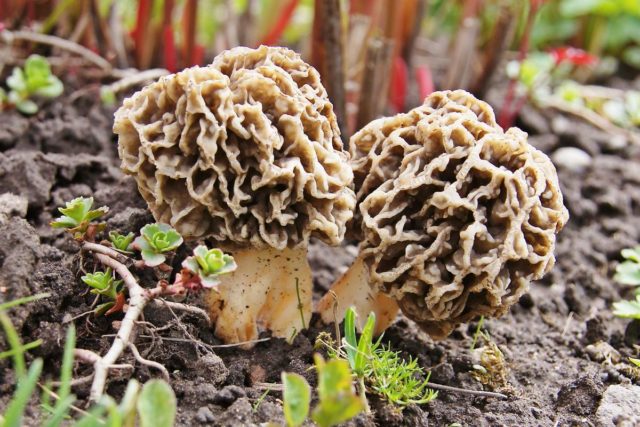
Semi-free morel
The mushroom has a pronounced stem and cap. Its average height is 10 cm. Sometimes representatives of this group grow up to 20 cm. Their internal cavities are not filled with anything. The cream stem breaks easily. Its height is from 5 to 12 cm, its girth reaches 3 cm. Its surface is rough to the touch.
The cap reaches 2 - 4 cm in height. Its upper part fuses with the leg, its edges remain free. There are irregular folds on the surface. There are clear ribs that gradually turn black. The color of the cap is brown, light or dark.
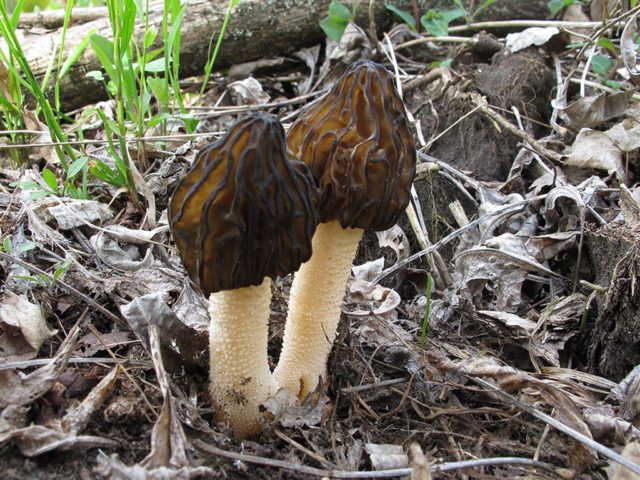
Steppe morel
This large mushroom grows up to 25 cm in height. Its weight reaches 2 kg. Prefers open areas: steppes, meadows, clearings. The steppe variety has a gray-brown spherical cap measuring from 2 to 10 cm, the edges of which grow to a cream-colored stem.
The steppe species is developing rapidly. The fruiting body is formed in 7 days. In spring, the steppe variety often grows in groups. If the winter turns out to be little snow, then the mushrooms do not have enough moisture to develop. The dense white pulp is characterized by the absence of voids. Numerous cells are clearly visible on the cap.
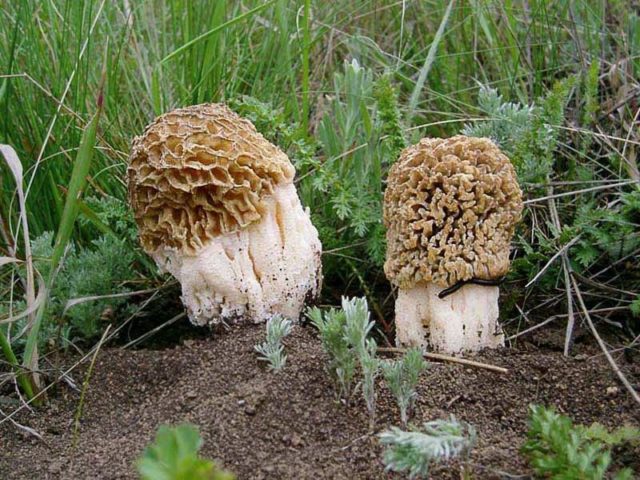
stinky morel
The mushroom is also known as Veselka vulgaris. It reaches a height of 10 - 30 cm. Its fruit body is egg-shaped, with a girth of 6 cm. The shell is leathery, smooth, white or cream-colored. Inside there is gelatinous pulp.
As the vesel grows, a spongy cylindrical leg forms. Then a cap up to 5 cm high is formed. Its surface is cellular, mucous, dark olive in color. There is a disc-shaped hole at the top. Mature specimens have an unpleasant rotting odor.
Veselka vulgaris is not used when it reaches full maturity. Within a few hours, the pulp decomposes. Veselka is harvested in the early stages of growth, when it has the shape of an egg or a traditional mushroom.
Attention! The stinking morel has the highest growth vigor in nature. In a minute its dimensions increase by 5 mm.

general characteristics
Spring morels have a unique appearance; a detailed description of the mushroom is given in the table.
| Size | Approximate diameter 3-6 cm, height about 3-7 cm. |
| Form | Conical, with a pointed tip. |
| Color | The shade varies from light brown to dark brown |
| Leg | Average height - up to 10 cm, thickness from 1.5 to 8 cm. Glossy snow-white or yellow-brown, thick, cylindrical in shape. The surface is furrowed, folded or scaly. |
| hat | It has a different shape: cone, bell or egg, consisting of numerous ribs-cells. Outwardly it resembles a honeycomb from a beehive. |
| Hymenophore | Smooth (without plates and tubes). Spores develop in special bags (asci) - 8 in each. These bags form a spore-bearing layer located along the bottom and slopes of the ribs. |
| Pulp | Brittle, white in color with a pleasant mushroom aroma. |
Approximate prices for 1 kg of fruiting bodies:
- fresh - about 250-270 rubles;
- dried ones are more expensive - from 3000 rubles.
What do morel mushrooms look like?
Morels are large mushrooms with a fleshy, fragile fruiting body. They usually consist of a stem and a cap. Their surface is wrinkled, reminiscent of a honeycomb, only empty and narrower. The bell-shaped cap has a spore-bearing layer, its surface is spongy or wavy. The edges may adhere to the stem or remain free. The color of the cap is brown.
The height of the mushrooms is 2 to 25 cm. Their legs are white, brown or yellowish, cylindrical in shape. Sometimes there is a thickening near the base. The surface of the leg is smooth or scaly.
The fruiting body has cavities inside and consists of numerous branches. They are separated by partitions; in the center there are pores for the transfer of useful substances. The pulp is white, waxy, thin, and breaks easily.
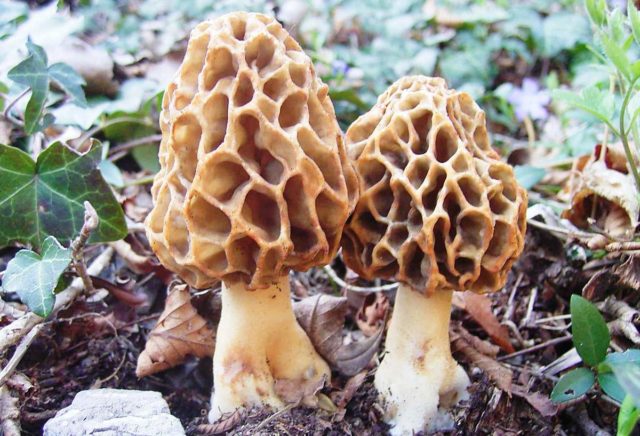
Where do morels grow?
Often these representatives are found in parks, forest and steppe areas. In addition, they appear in the 3rd – 4th year after fires and fellings.
In what areas do morels grow?
The morel grows in a temperate climate zone. It is collected in Eurasia, North America and Australia. Some species are found in Mexico, India, and Turkey.
Five varieties are well known in Russia. Morel mushrooms live in the Moscow region, Tver, Ulyanovsk, Samara, Rostov regions. They are also found in the Urals, Altai, Siberia, and Primorsky Territory.
In which forests do morels grow?
Morels prefer well-lit areas. They grow in fertile soil saturated with lime. They are more often found alone, rarely forming groups. They are collected in coniferous and mixed forests, parks and apple orchards.
Sometimes representatives of the Morel family appear on sandy soils. In the southern regions they are collected from lawns and garden plots. When searching, it is recommended to check ravines, banks of rivers and streams, fallen trees, but it is easier to conduct a “silent hunt” in clearings, lawns, and next to forest paths overgrown with tall grass.
Poisonous varieties
The most toxic and poisonous mushrooms in the marsupial family are:
No. 1 - Ordinary stitch
The harm from using an ordinary stitch has been scientifically proven. Its pulp contains the poison gyromitrin, which persists even after heat treatment. Regardless of the number of boils and drains of water, toxins do not decompose and can cause irreparable harm to the human body.
And if in conditionally edible lines, gyromitrin is destroyed when dried at high temperatures. Contents in large volumes in an ordinary line do not allow the harm to be reduced even to a minimum.
Statistics of poisonings and deaths are more common in Germany than in Russia, Belarus and Ukraine. However, cases of intoxication are still registered. Therefore, doctors prohibit consuming fruit pulp even in small quantities.
Interesting fact!
Until now, many scientists are at a loss as to why the lines collected in the Federal Republic of Germany contain more poison in their pulp than in the regions of Russia and European cities. The only thing that could be confirmed was the increase in gyromitrin due to the place of germination: soil pollution, air pollution and arid climate. Volumes also depend on the strain of the fungus. Scientific studies conducted by German researchers revealed a huge content of gyromitrin per 1 kg of fresh product. Consuming such a volume of stitches can lead not only to poisoning and intoxication, but also to failure of internal organs, resulting in death. There are no such observations in Europe. The minimum content of poison in conditionally edible varieties dissolves under the influence of high temperatures. After drying after 90 days, the mushrooms are ready to eat.
Important!
The high content of gyromitrin is comparable to the poison contained in the pulp of the most dangerous mushroom - toadstool. Poisoning does not take long to appear, showing symptoms after a short time.
No. 2 – Autumn stitch
The autumn variety is also included in the list of conditionally edible ones. The third category is characterized by a minimal content of toxins that decompose after drying. Boiling for further preparation is not recommended at all. Gyromitrin does not decompose after boiling even after repeated boiling. The high temperature used during drying can only destroy small amounts of poison. The use of this method with poisonous mushrooms is inappropriate.
The look of the fall stitching is classic. The cap is large, externally similar to the kernel of a walnut. It is colored red, less often yellowish-gray. The leg is not large, flat and wide, hidden behind the upper part of the fruit.
After drying, the line can be used within 90-120 days. Only during this period do toxins completely decompose.
Mushrooms similar to morels
Morels are similar in appearance to other mushrooms that grow in early spring. They are often confused with strings that contain dangerous poison and are called false morels.
Strog is a spring marsupial mushroom similar to a morel. When eaten, the toxin that the mushroom contains changes the composition of the blood. The lethal dose of such a product is 0.4 - 1 kg. To remove poison from the pulp, you need to cook it for at least 10 minutes. All the poison then goes into the water, which must be drained. Then the mass is washed with clean water.
The stitch and the morel have obvious differences. The first ones have a shapeless cap that resembles the convolutions of the brain. Morels have a cone-shaped, elongated cap. The lines do not push the soil apart, but grow through it, so their stems need to be cleared of soil, small branches and other debris.
To distinguish between these types of mushrooms, you need to cut off their stem. Morels have a hollow interior, not filled with anything. The stitches are distinguished by a uniform, sinuous flesh; In addition, they do not have a pronounced mushroom smell.
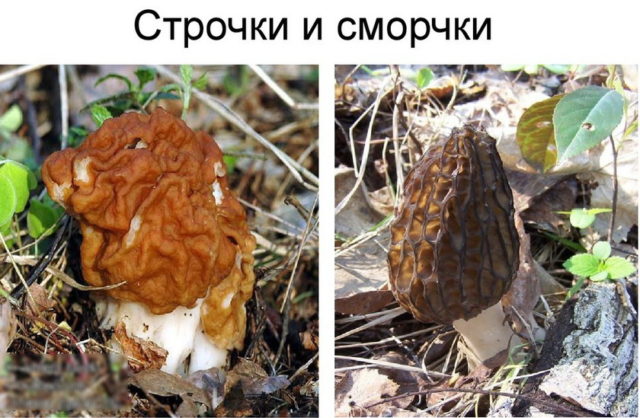
Can you eat or not?
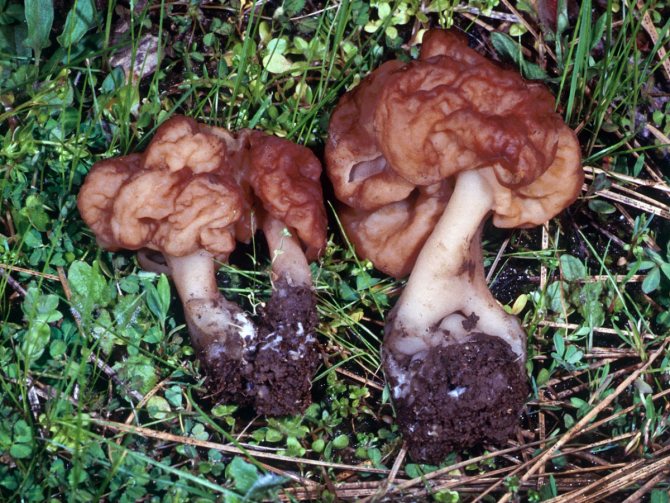
As for the edibility of both morels and strings, there are conflicting opinions on this matter. Some argue that such mushrooms are deadly poisonous and should not be eaten under any circumstances. Others regularly collect them and eat them without any noticeable harm to health.
One way or another, the lines contain a toxic substance, gyromitrin, which is very toxic when taken orally in its raw form. But the same substance becomes harmless if the mushroom is boiled in water, so the line is classified as conditionally edible.
How to prepare it correctly to avoid health risks? Mushroom pickers recommend following the following rules:
- Before using, the stitches must be boiled in several stages, draining the water after each time;
- total cooking time - about 1 hour;
- The lid must be open when cooking;
- it is advisable not to inhale the vapors of the water in which the forest products are boiled;
- after cooking, the mushrooms can be fried or stewed;
- The water in which the stitches were boiled is not consumed.
Tables with descriptions of edible, poisonous and non-poisonous mushrooms
Strings are a tasty product ; in France, along with morels, they are considered a delicacy, since iti mushrooms are closely related to the famous truffles. The fruit body of the morel in its raw form does not have such a pronounced aroma as the truffle has, but when cooked, its taste is incredibly subtle and gives off nutty notes, like a truffle, and the flesh of the mushroom has the most delicate taste. String has a more neutral taste, but dishes made from it also turn out appetizing.
Why are morels useful?
Since ancient times, representatives of morels have been used to treat eye diseases, improve myopia and age-related farsightedness. The composition contains substances that strengthen the eye muscles and protect the lens from clouding. Based on these fungi, drugs are being developed to combat cataracts.
In folk medicine, the product is used to treat diseases of the stomach and intestines. A tincture of these mushrooms is a good remedy against conjunctivitis. The pulp also contains polysaccharides, which suppress the activity of cancer cells and viruses and stimulate the immune system.
Use of stitch mushroom in medicine
String is a mushroom that is often used not only in cooking, but also in folk medicine. The first spring mushrooms are used as medicine to treat a number of diseases:
- radiculitis;
- myositis;
- eye diseases;
- rheumatism;
- osteochondrosis;
- arthritis;
- rheumatism.
An alcohol tincture is made from the fruits and used for rubbing external surfaces. To prepare the miracle remedy, use 50 g of dried stitches and 0.7 liters of medical alcohol, diluted to 45-50% with boiled water. After stirring, the resulting mixture is covered with a nylon lid and placed in the refrigerator for 3 weeks. After time, the infusion is used for rubbing and alcohol compresses. For the desired effect, the place where the mushroom infusion is applied is wrapped in a woolen scarf.
The second recipe involves adding melted honey to the alcohol tincture. For 700 ml of diluted alcohol, take 7 tablespoons. l. natural honey. After a few weeks, the solution is used for rubbing and compresses. 30-40 minutes after the procedure, the area is washed with warm water and wiped dry, covered with warm material.
First aid for morel mushroom poisoning
In case of fungal poisoning, the victim is given first aid:
- wash the stomach;
- give activated carbon or other sorbent to drink;
- include drinking large amounts of warm liquids.
It is necessary to quickly remove dangerous toxins from the patient’s body. A doctor is called to treat the poisoning. The specialist will prescribe treatment or decide to transfer the patient to a hospital. The rehabilitation period takes up to several weeks, depending on the age and condition of the victim.
